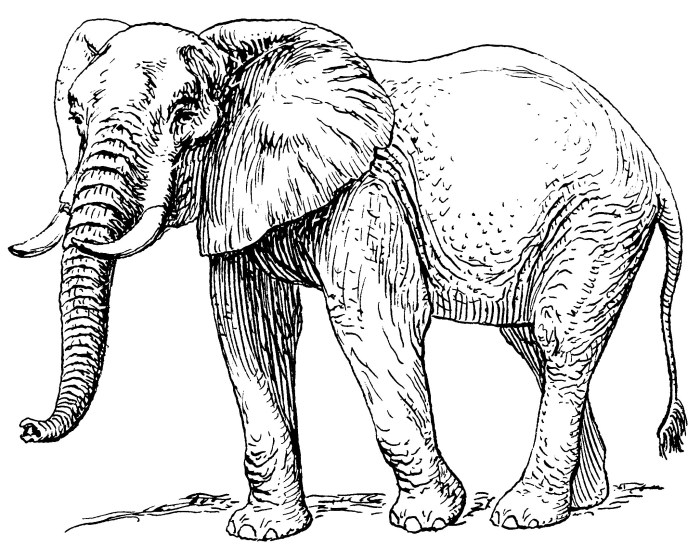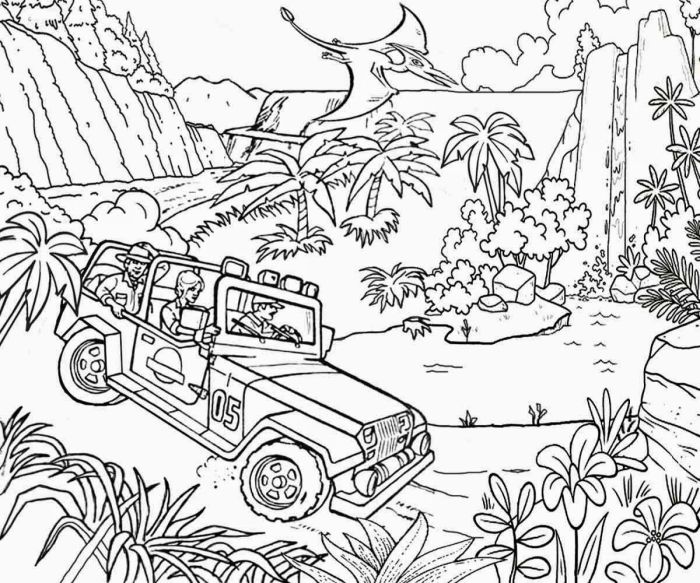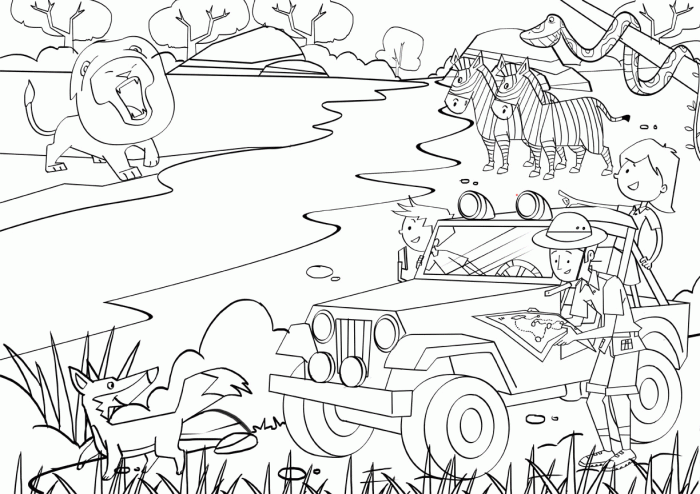Popularity and Trends of Safari Coloring Pages

Safari-themed coloring pages enjoy significant popularity across a broad spectrum of age groups, driven by the inherent appeal of wildlife and the engaging nature of the activity itself. Their popularity transcends geographical boundaries and cultural differences, making them a consistent choice for entertainment and creative expression.Safari coloring pages cater to diverse preferences and skill levels, contributing to their widespread appeal.
The inherent visual richness of the subject matter, coupled with the adaptability of the format, ensures consistent demand.
Popularity Across Age Groups
The enduring appeal of safari coloring pages extends across various age demographics. Younger children are drawn to the simplified, cartoonish designs, focusing on bold colors and recognizable animal shapes. Older children and teenagers may gravitate towards more realistic depictions, allowing for more detailed coloring and artistic expression. Adults find them a relaxing and therapeutic activity, offering a creative outlet and a means of stress reduction.
The adaptability of the designs allows for participation across generations.
Popular Safari Animals
Lions, elephants, giraffes, zebras, and monkeys consistently rank among the most popular animals featured in safari coloring pages. These animals are instantly recognizable, visually striking, and possess characteristics that lend themselves well to artistic interpretation. Other frequently depicted animals include leopards, rhinos, cheetahs, and various bird species like flamingos and parrots. The selection often reflects a balance between iconic species and those that offer visual interest for coloring.
Stylistic Trends in Safari Coloring Page Designs
Safari coloring pages showcase a diverse range of stylistic approaches. Simple, line-art designs are prevalent, particularly for younger children, emphasizing clear Artikels and basic shapes. More complex designs incorporate intricate details, realistic textures, and shading, catering to older children and adults who seek a more challenging and rewarding coloring experience. Cartoonish styles, often employing exaggerated features and humorous expressions, are also common, injecting a playful element into the designs.
The variety in styles allows for a broad appeal, accommodating diverse preferences and skill levels.
Safari coloring pages offer a vibrant journey into the wild, perfect for sparking creativity. For those wanting to incorporate literacy into their artistic pursuits, combining these animal illustrations with coloring pages with letters can create engaging educational activities. This way, children can learn the alphabet while enjoying the thrill of coloring majestic lions, playful monkeys, or elegant giraffes in their safari adventures.
Printable vs. Digital Safari Coloring Pages
Both printable and digital safari coloring pages enjoy widespread availability. Printable pages offer the tangible experience of holding and coloring a physical sheet, appealing to those who prefer traditional methods. Digital coloring pages, on the other hand, provide convenience and flexibility, allowing for easy access, sharing, and the use of digital coloring tools. The availability of both formats ensures accessibility for a wide range of users, catering to diverse preferences and technological capabilities.
Many websites offer free printable pages, while others provide paid digital versions with enhanced features and design options.
Design Elements of Effective Safari Coloring Pages

Creating engaging safari coloring pages for children requires careful consideration of several key design elements. These elements work together to produce pages that are not only fun to color but also stimulate creativity and visual learning. A well-designed page will be appealing to a child’s sense of aesthetics while also providing a satisfying coloring experience.
Line Weight and Simplicity in Design
The line weight of a safari coloring page significantly impacts its ease of coloring. Thick, bold lines are ideal for younger children who may still be developing their fine motor skills. These lines provide a clear and easy-to-follow Artikel, minimizing frustration and maximizing the enjoyment of the coloring process. Conversely, thinner lines can be incorporated for older children who are more adept at coloring and prefer more detailed designs.
Simplicity in the overall design is also crucial. Avoid overly complex shapes and intricate details that might overwhelm a child. A balanced design, featuring a mix of simple and slightly more detailed elements, is often the most effective. For instance, a large, simple elephant shape could be complemented by smaller, more detailed features like its ears and trunk.
Positive and Negative Space in Design
The effective use of positive and negative space is paramount in creating visually appealing safari coloring pages. Positive space refers to the areas occupied by the animal illustrations, while negative space is the empty space surrounding them. A well-balanced ratio between positive and negative space creates a visually pleasing composition, preventing the page from feeling cluttered or overwhelming.
Leaving ample negative space around the main subject allows the illustration to breathe and enhances its visual impact. For example, a lion in a vast savannah setting utilizes negative space effectively to highlight the lion and evoke a sense of its habitat. Too much positive space, conversely, can make the design feel cramped and less appealing.
Color Palettes for Safari Animal Coloring Pages
A thoughtfully chosen color palette can significantly enhance the overall appeal of a safari coloring page. Here are some examples of color palettes suitable for different safari animals, presented in a table for easy reference:
| Color Name | Hex Code | Color Name | Hex Code | Color Name | Hex Code | Color Name | Hex Code |
| Warm Brown | #A0522D | Sandy Beige | #F5F5DC | Olive Green | #808000 | Deep Orange | #FF8C00 |
| Jungle Green | #228B22 | Tawny | #D78163 | Golden Yellow | #FFD700 | Slate Grey | #708090 |
| Terracotta | #E2725B | Light Khaki | #F0E68C | Forest Green | #228B22 | Dark Brown | #8B4513 |
| Dusty Rose | #B26666 | Cream | #FFFDD0 | Azure | #F0FFFF | Midnight Blue | #191970 |
These palettes offer a variety of options, allowing for creativity and adaptation to different animals and scenes. For instance, the first palette is well-suited for coloring a lion or giraffe, while the second could be used for a more lush jungle scene featuring monkeys or parrots. Remember to encourage children to experiment and develop their own unique color combinations.
Educational Value and Applications of Safari Coloring Pages
Safari coloring pages offer a surprisingly rich educational experience for children, extending far beyond simple entertainment. The act of coloring itself contributes to cognitive development, while the safari theme provides a unique opportunity to learn about diverse animals and their environments. This section explores the educational benefits and practical applications of these engaging activities.
Coloring fosters fine motor skill development, hand-eye coordination, and improves focus and concentration. The careful control required to stay within the lines strengthens small muscles in the hands and fingers, preparing children for writing and other fine motor tasks. The process of choosing colors, blending shades, and completing the image also enhances creativity and self-expression. Furthermore, the thematic nature of safari coloring pages provides a platform for learning about the natural world in a fun and engaging way.
Safari Coloring Pages Enhance Knowledge of Animals and Habitats
Safari coloring pages effectively introduce children to a wide variety of animals and their natural habitats. By depicting animals in their respective environments – a lion in the savanna, a giraffe in the acacia trees, a monkey swinging through a jungle – these coloring pages provide visual context and enhance understanding. The act of coloring reinforces the visual memory of these animals and their surroundings, leading to improved knowledge retention.
Children can learn to differentiate between various species, identify key physical characteristics, and associate animals with their appropriate habitats. For instance, a coloring page featuring a polar bear in an arctic landscape helps children understand the animal’s adaptation to cold climates.
Incorporating Safari Coloring Pages into Lesson Plans
Educators can seamlessly integrate safari coloring pages into diverse lesson plans across various subjects. In science classes, these pages can supplement lessons on animal classification, habitats, and ecosystems. In art classes, they offer opportunities for creative expression and color exploration. Even in language arts, coloring pages can inspire creative writing prompts, such as storytelling about the animals depicted.
For example, a teacher could introduce a lesson on African wildlife by showing pictures of various animals. Following this introduction, students could receive a safari coloring page featuring several African animals. After completing the coloring page, a class discussion could focus on identifying the animals, discussing their characteristics, and comparing their habitats. This multi-sensory approach combines visual learning with active participation, enhancing comprehension and engagement.
Lesson Plan: Animal Characteristics – Focusing on Camouflage
This lesson plan utilizes a safari coloring page to teach children about animal camouflage.
Objectives:
Students will be able to define camouflage and identify its purpose. Students will be able to identify animals that use camouflage and explain how their coloring helps them survive.
Materials:
Safari coloring page featuring animals known for camouflage (e.g., chameleon, leopard, praying mantis). Crayons, colored pencils, or markers. Reference images of the animals showing their camouflage in action.
Procedure:
- Introduce the concept of camouflage: Explain that camouflage is a way animals blend in with their surroundings to hide from predators or prey.
- Distribute the safari coloring page. Encourage students to carefully observe the animals depicted, paying close attention to their colors and patterns.
- Guide students to color the animals accurately, reflecting their natural camouflage. Discuss how their coloring helps them survive in their environments.
- Show reference images of the animals in their natural habitats. Compare the coloring page to the real-life examples, highlighting the effectiveness of the camouflage.
- Conclude with a class discussion about other animals that use camouflage and how it benefits them.
Creative Variations and Extensions of Safari Coloring Pages

Safari coloring pages offer a fantastic foundation for creative exploration, extending far beyond simple depictions of animals. By incorporating interactive elements and engaging narratives, these pages can become significantly more enriching and stimulating for children. This section explores various ways to enhance the basic safari coloring page concept, transforming it into a more dynamic and educational tool.
Adding interactive elements and creative variations can significantly boost the engagement and educational value of safari coloring pages. This can be achieved through the integration of puzzles, mazes, storytelling elements, and interactive digital components. The following sections detail these methods.
Incorporating Puzzles, Mazes, and Storytelling Elements
Integrating puzzles, mazes, and storytelling elements into safari coloring pages transforms them from simple coloring activities into engaging learning experiences. For example, a maze could lead a child’s colored pencil through a savanna to reach a watering hole, or a puzzle could require assembling parts of a fragmented animal image. A storyline can unfold across a series of pages, with each page presenting a new scene or challenge.
This multi-faceted approach fosters creativity, problem-solving skills, and narrative comprehension.
Interactive Elements in Digital Safari Coloring Pages
Digital safari coloring pages offer unique opportunities for interactivity. Features like sound effects (the roar of a lion, the chirp of a bird) triggered by coloring specific areas can enhance the experience. Animation, where animals move or react as the child colors, can also be incorporated. Interactive elements could include quizzes on animal facts, or drag-and-drop activities where children match animals to their habitats.
These interactive features create a dynamic and engaging digital learning experience.
Potential Storylines for Safari Coloring Page Series
A series of safari coloring pages can effectively tell a compelling story. Here are a few potential narratives:
- A young cheetah’s first hunt: The series could depict the cheetah learning to stalk, chase, and finally catch its prey.
- A family of elephants’ migration: Each page could showcase a different stage of their journey, highlighting the challenges and triumphs.
- A monkey’s search for lost bananas: The monkey’s adventure could involve navigating obstacles and encountering various animals.
- The day in the life of a lion pride: The series could illustrate the daily activities of the pride, from hunting to resting.
- Building a safari lodge: The series would focus on the construction of a safari lodge, showcasing the different stages and the animals involved.
Creating a Safari Coloring Page Scene with Perspective and Depth, Safari coloring pages
Consider a scene depicting a watering hole in the heart of the African savanna. In the foreground, a herd of zebras drinks peacefully, their stripes vividly contrasting against the parched earth. Slightly further back, a family of giraffes elegantly reaches for acacia leaves, their long necks stretching towards the higher branches. The middle ground features a group of wildebeests grazing, creating a sense of movement and life.
In the background, a hazy, blue-toned mountain range provides a backdrop, lending a sense of depth and distance. The use of varying sizes for the animals and the placement of elements further enhances the perspective, with the closest animals appearing larger and more detailed than those in the background. The overall effect creates a three-dimensional feel within a two-dimensional space, enriching the coloring experience.
Marketing and Distribution of Safari Coloring Pages
Successfully marketing and distributing safari coloring pages requires a multifaceted approach encompassing diverse online and offline platforms, compelling marketing materials, and a well-defined pricing strategy. This section will explore effective methods for reaching the target audience and maximizing sales.
Platforms for Marketing and Distribution
Several avenues exist for promoting and selling safari coloring pages. Online marketplaces like Etsy and Creative Market offer established platforms with built-in audiences. A dedicated website provides greater control over branding and customer interaction, allowing for direct sales and email list building. Social media platforms such as Instagram, Pinterest, and Facebook are crucial for visual marketing, engaging with potential customers, and driving traffic to sales channels.
Finally, collaborations with parenting blogs, educational websites, and relevant influencers can significantly expand reach and credibility.
Strategies for Creating Visually Appealing Marketing Materials
High-quality visuals are paramount for attracting attention in a crowded digital landscape. Marketing materials should showcase the coloring pages’ vibrant designs and intricate details. This can be achieved through professionally designed mockups featuring children happily coloring the pages, or showcasing finished, colored examples. Short, engaging video clips demonstrating the coloring process or highlighting specific animal features can also be highly effective.
Consistent branding across all platforms, including a memorable logo and color scheme, is essential for building brand recognition.
Pricing Models for Digital and Printable Safari Coloring Pages
Pricing strategies vary depending on the format and value proposition. Digital coloring pages, offered as instant downloads, typically command lower prices than physical print-on-demand options due to reduced production costs. A tiered pricing model, offering individual pages, bundles of related themes (e.g., “Big Five” animals), or complete collections, can cater to diverse customer needs and budgets. Consider offering a “pay-what-you-want” option for a limited time to generate initial interest and reviews.
For printable versions, consider incorporating additional value, such as bonus coloring sheets or activity pages, to justify a higher price point. Analyzing competitor pricing and adjusting based on perceived value is key. For example, a single digital page might cost $1-$3, while a bundle could range from $5-$15. Print-on-demand services will add their own costs and profit margins to these prices.
Marketing Plan for a New Collection of Safari-Themed Coloring Pages
This plan targets parents of children aged 3-8, educators seeking engaging classroom materials, and individuals interested in wildlife and nature. Marketing channels will include social media campaigns on Instagram and Pinterest, featuring visually appealing images and short videos. Paid advertising on Facebook and Instagram will target parents and educators within the specified age range. Collaboration with relevant parenting and education bloggers will be pursued to review and promote the coloring pages.
The website will offer a user-friendly interface with clear product descriptions and high-quality images. A tiered pricing strategy will be employed, offering individual pages at $1.50, themed bundles at $8, and a complete collection at $15. This pricing structure offers flexibility and value, catering to various budgets and needs. A launch discount will be offered for a limited time to encourage initial sales and build momentum.
